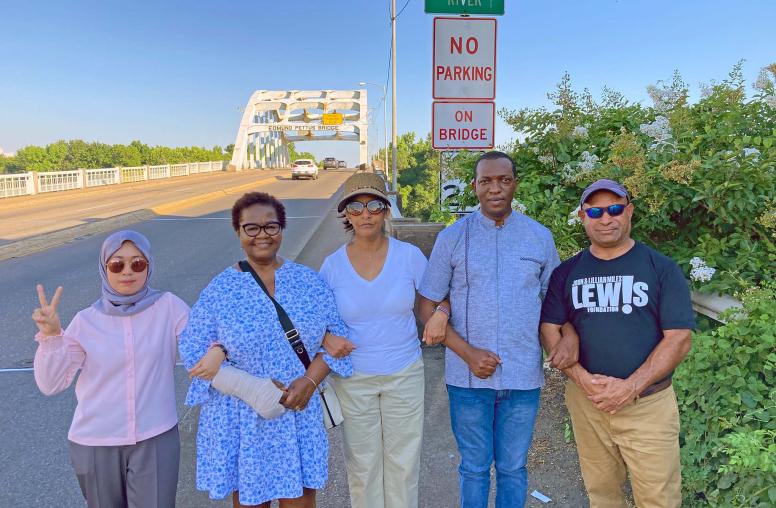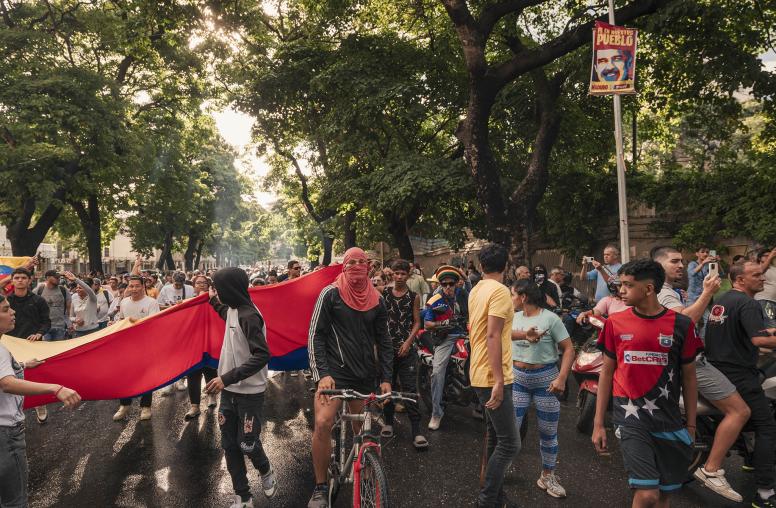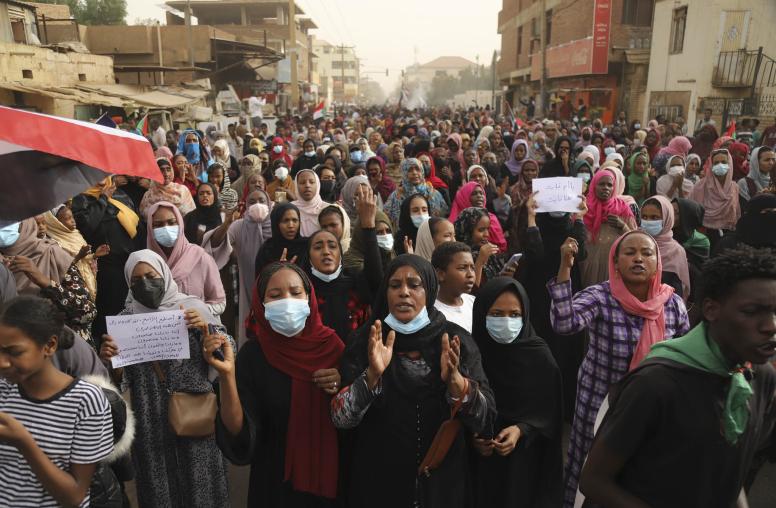Maria Stephan on What We Get Wrong About Protest Movements
This year has seen an extraordinary rise in people power. Despite significant coverage of these movements, many misconceptions about how they work persist. USIP’s Maria J. Stephan addresses those myths and says, “The most defining variable of successful nonviolent movements is large, diverse and sustained participation.”
On Peace is a weekly podcast sponsored by USIP and Sirius XM POTUS Ch. 124. Each week, USIP experts tackle the latest foreign policy issues from around the world.
Transcript
Ken Klein: We have seen over the last 10 years, as we sort of reassess where we are the end of this decade, the arise of things like, for example, the Arab Spring, and more recently, we've seen protests in Hong Kong, for example, more protests in India. The question is whether or not there are some givens about demonstrations and protest movements. Well, our next guest, along with her colleague Adam Gallagher, Maria Stephan has put together a list of myths about protest movements. Maria is the United States Institute of Peace’s director of nonviolent action, tweeting @MariaJStephan, S-T-E-P-H-A-N. Maria Stephan, welcome. Thank you for being on POTUS today.
Maria Stephan: Good morning, Ken. Thanks for having me on. Ken Klein: Let's see if we can get through these. Myth number one: social media, you wrote, has made popular movements more effective. That's a myth.
Maria Stephan: Yeah. Well, social media has definitely contributed to the explosion of protests that we've seen around the world, certainly, this past year: Lebanon, Iraq, Sudan, Algeria, Chile, Hong Kong, Colombia. There's been a resurgence of protests happening around the world, and what Facebook and Twitter provide is fast communication, people can access information easier. So protest and getting out into the streets has become a lot easier, but we're making the argument that that has not necessarily translated into more effective movements which, as we know, require lots of organization, relationship building, trust building, leadership and these are qualities and attributes that social media don't always support.
Ken Klein: Yeah. I mean we've seen that before. People think, by sending a tweet or a hashtag, that, all of a sudden, they've done their part and it doesn't usually turn out that way, am I right?
Maria Stephan: That's right. That's right, yeah, no, and movements are based on people in large collective action and structures and organizations. You look at the protests in Sudan that ultimately led to the ouster of the 30-year dictator, Omar al-Bashir, this was a movement that faced mass, brutal repression by state and non-state forces, security forces. It was able to survive because it had such an extensive network of grassroots organizations, neighborhood committees, professional associations who provided kind of the grassroots backbone for the movement that allowed it to remain resilient.
Ken Klein: On myth number two, you quote The Economist, saying that violent protest is actually more effective. The Chronicle of Higher Education in 2013 had Benjamin Ginsberg writing, "those willing to use violence to achieve their goals will generally overcome their less bellicose adversaries." But your myth is that nonviolent resistance is useless against certain foes. Explain.
Maria Stephan: Yeah. There's often the perception that nonviolence or nonviolent action can only work against more benign opponents or in a democratic context or... but in places where the government's cracked down heavily, brutally with violence, that it's hard to win with nonviolent action. And in fact, the research, including some research that I've conducted with a colleague, Erica Chenoweth, has found that nonviolent resistance has often emerged and succeeded in places where we would think it would fail. We looked at around just over 330 major violent and nonviolent campaigns over the past century and were able to conclude that the nonviolent campaigns that relied on primarily nonviolent tactics— boycott, strikes, sit-ins, civil disobedience, protests and the like— were twice as effective as the armed movements facing the same opponents, so nonviolent resistance can prevail even against these very difficult opponents.
Ken Klein: Maria Stephan, the United States Institute of Peace director of nonviolent action, with us discussing the five myths about protest movements. Myth number three: nonviolent movements require charismatic leaders. We do tend to think of people and associate them with movements, as you point out in the piece, Lech Walesa in Poland, for example, but that's a myth, you say.
Maria Stephan: Well, certainly, when we think of the iconic nonviolent struggles historically, Mahatma Gandhi and the Indian independence movement, Martin Luther King's civil rights movement, they play outsize roles in these movements, but movements don't rely on single leaders, and single leaders and charismatic leaders bring a lot of risk with them.
Over-reliance on single leaders can kind of undermine the power of a movement if those leaders get arrested or detained or the like, that can kind of undermine the movement and its ability to go forward. Leadership matters, though, and what we're seeing today in places like Chile and Sudan and Hong Kong is that these movements are very leader-full, let's say, so they've got a lot of leaders taking action in decentralized networks. And so the important thing is that there's leadership structures and people are able to take decisions and actions, but movements are able to survive, endure through these decentralized leader-full structures in a way that may challenge the prevailing assumptions about why movements succeed.
Ken Klein: Let's get to myth number four, and I was thinking specifically of Hong Kong in this case. The myth is that popular movements are all about street demonstrations. We've seen a lot of that in Hong Kong, but it doesn't appear clear, at this point, that this is going to result in changes. Talk about that myth.
Maria Stephan: Yeah. Street protests, I mean they're a really important, powerful tactic of nonviolent resistance. Getting out into the streets, challenging authority, being visible allows people to see that other people are dissenting and kind of join, so protests are important, but we know that protests are also vulnerable to repression. Bringing large numbers of people together can make them vulnerable to state violence. Movements succeed when they involve lots of different types of tactics that can involve different types of people that have varying risk levels, different skills and abilities. And so you think of some of the most powerful nonviolent tactics out there, and there are thousands, by the way.
It's very hard to exhaust the nonviolent arsenal. But you think of some of the most powerful tactics, consumer boycotts, labor strikes, and these are, these don't involve confrontations with security forces. These involve people refusing to obey, not cooperating, withholding their paying power. These are all really powerful tactics in nonviolent movements. Over-reliance on single tactics is usually a bad thing for movements. Being able to alternate and bring in these different methods of descent makes movements more resilient to repression and helps get a lot more people involved.
Ken Klein: Maria Stephan with the United States Institute of Peace. She is director of nonviolent action. Let's talk about myth number five. Protesters are fighting for progressive goals, sometimes, but this is certainly not an exclusive goal for protesters, I guess.
Maria Stephan: That's true. I mean, the predominant image is of young people out in the streets fighting against dictatorship, authoritarianism, and there are lots of, and probably the vast majority of protests involve folks out there fighting for social justice issues, but we know that other people have discovered nonviolent tactics and civil resistance methods: nativists, chauvinists, white supremacists. We've seen a lot of far-right rallies in Europe, in Germany, in Poland, in this country. People are using the marches, the demonstrations, the sit-ins, the boycotts, all of these tactics can really be used for so-called good or bad goals, so yeah, this is not a method of resistance that is exclusive to one type of people.
Ken Klein: Is there anything, as we've now covered those five myths, is there anything that typifies, if you will, a successful nonviolent movement? Is it a lot of things combined? Is it social media and street protest and action behind the scenes and a charismatic leader or, I mean, a combination of any or all of those?
Maria Stephan: I would say the most defining variable of successful nonviolent movements is the large, diverse and sustained participation. Mass movements have lots of people from different segments of society. Youth tend to be in the forefront, as we've seen in places around the world, but when they're joined by religious leaders, women, elderly, disabled, so movements that bring in lots of different people who have different sources of power, skills and the like that are able to sustain their participation over time. This is where the organization comes in. It's not just about one mass street rally or demonstration or one click or tweet, as you say. It's about the ability to keep people organized, to sustain their participation over time. I would also say being able to integrate different tactics, so the boycotts, the strikes, the sit-ins, to the silent protest. Not everything has to be loud and boisterous and the like, so being able to kind of mix it up tactically, but the large, sustained, diverse participation is really, really key for successful movements.
Ken Klein: We will leave it there, but for people who want to refer to the piece, it's “The Five Myths About Protest Movements”. You could find it in The Washington Post. Maria, thank you for joining us on POTUS today.
Maria Stephan: Thanks so much.
Ken Klein: Maria J. Stephan, along with Adam Gallagher, penning that piece that is in The Washington Post. Maria is the United States Institute of Peace director of nonviolent action and joining us here on POTUS, tweeting @MariaJStephan, MariaJS-T-E-P-H-A-N.


